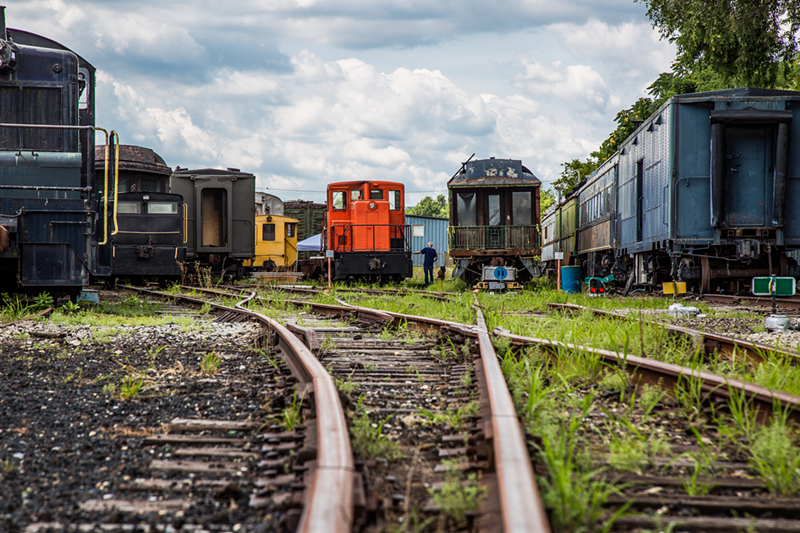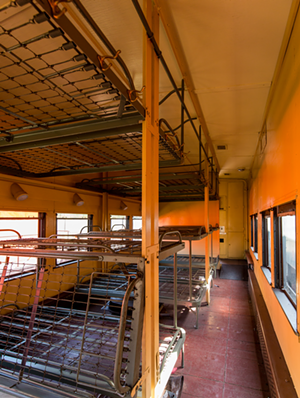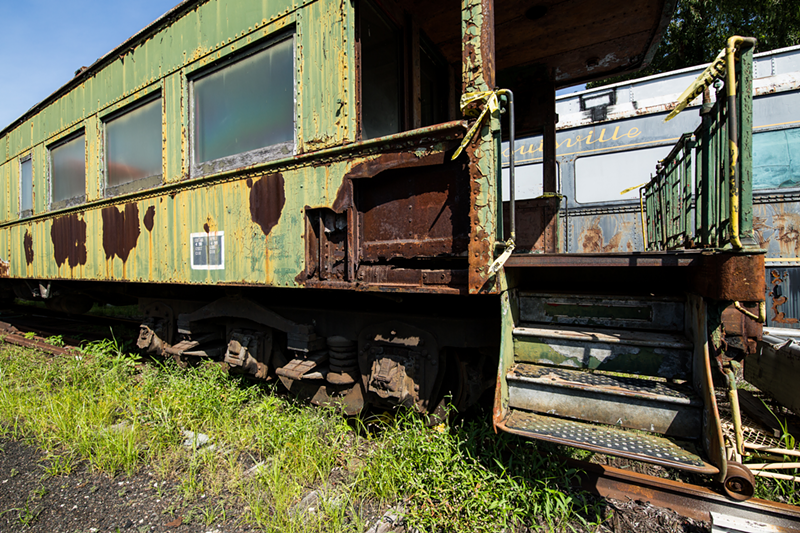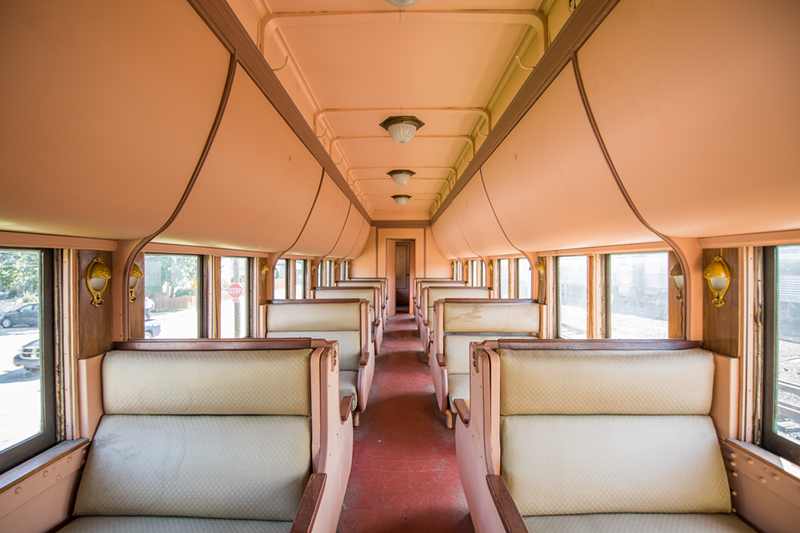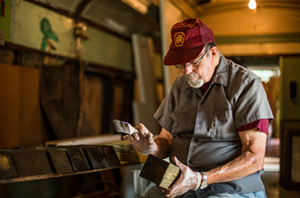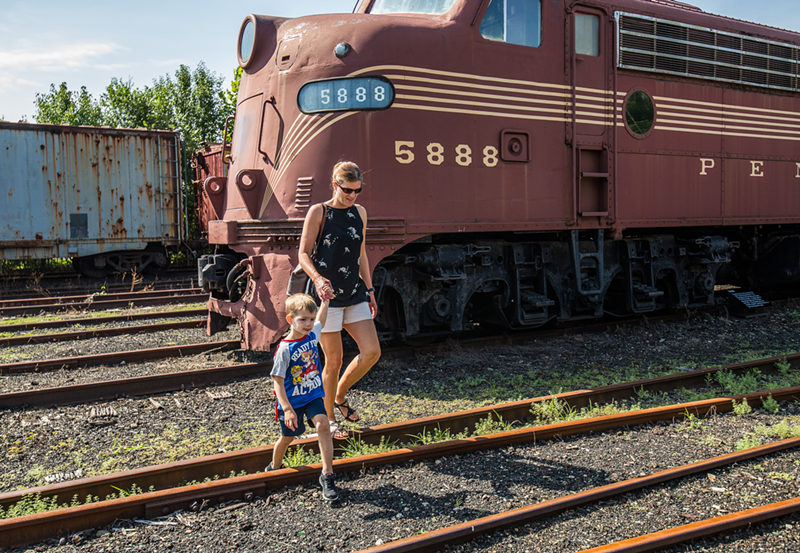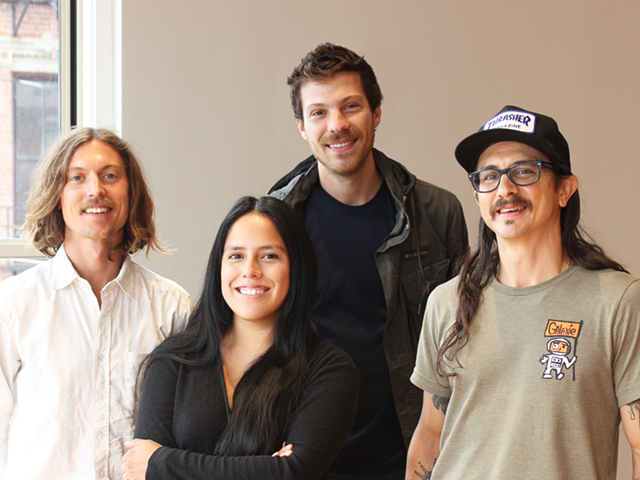“I think I can. I think I can. …”
This is a story about an optimistic little engine that has managed to chug along for 43 years but now is in a race against time.
Chances are you’ve been unaware of the Railway Museum of Greater Cincinnati and its collection of approximately 70 passenger and freight cars sitting in an old Louisville & Nashville (L&N) railyard in Covington’s Latonia neighborhood. It’s tucked away in a largely residential area a few miles from the interstate highways that supplanted the railroad system in the 1960s and ’70s. It’s open only on Saturdays during the summer and fall.
There’s no grand Art Deco station like Union Terminal to awe you. There’s no dinner train to take you into the countryside. There’s no docent-led tour on a paved path. Instead, you drop your $4 admission ($2 for kids) into a locked mailbox, and then step out to survey a mostly gritty lineup of locomotives and railcars spread over a few acres behind a chain-link fence.
“It’s modest,” acknowledges Tim Hyde, executive director of the nonprofit. “We know there’s not a lot here to look at.”
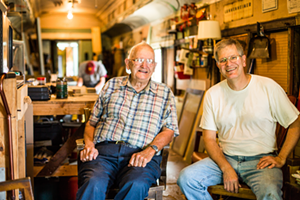
But, at the same time, he knows that these cars have important stories to tell — about wartime, black history and even the nation’s nutrition.
Brian Hackett, director of the Public History Program at Northern Kentucky University, agrees. He calls the outdoor, all-volunteer museum “one of the greatest treasures of the area” and “a diamond in the rough.” The nostalgic site has been a mecca for local photographers over the years, and Hollywood filmmakers, too.
The Railway Museum of Greater Cincinnati is a destination that’s all about Americans’ shared journey. For a moment, ignore the weeds, the broken glass and the deteriorating hulks sitting way in the back of the property, and focus instead on the familiar names and logos on cars that hauled people and freight across the country: Pullman, New York Central, the Pennsylvania Railroad, the Baltimore & Ohio. For a moment, allow your imagination to turn back the clock.
Yet, the reality is, age and rust are catching up with both the museum’s vehicles and its dozen active volunteers. Hyde’s father, who’s turning “a spry 90,” is part of the crew that sands, welds, paints and replaces whatever is missing on railcars that in some cases are older than he is. The next youngest helpers are around 75 and 60.
Hyde, who is in his mid-50s, says it’s been apparent for years that there is not enough manpower or money to save everything here from the effects of rain, snow and sun. The volunteers fear that without some big changes, in another decade, there could be nothing left worth saving.
Is this the end of the line? In the next month or so, Hyde and other board members will introduce a capital campaign to raise between $2 million and $2.5 million. The goal is to acquire more land, put 35 of the most important pieces in the collection under cover, open five or six days a week year-round, add paid staff and properly tell the history of railroads in our region.
Trains as Textbooks
Don’t fret if your knowledge of trains is limited to watching Thomas the Tank Engine. To survive and thrive, the museum wants to draw a general audience interested in American history, and not be seen merely as an attraction for railroading fans.
Just three pieces on the site — a 1981 L&N red caboose, a 1950 diesel locomotive and a 1944 troop sleeper-turned-B&O baggage car that serves as the museum’s entrance, restroom location and office — are always open for visitors to climb aboard during a self-guided tour. But if you approach one of the volunteers on the grounds, you might be treated to a personalized trip through the past, and a glimpse of what Hyde hopes will be the museum’s future.
Hyde’s day job is a stagehand, working on productions like the Cincinnati Opera’s recent presentation of Another Brick in the Wall. His knack for setting a scene becomes apparent as he unlocks a World War II troop sleeper Pullman car where volunteers are wrapping up about five years of work.
Fighting an enemy in both the Pacific and European theaters meant the U.S. quickly had to move tens of thousands of GIs to both coasts for assignment. But there were not enough passenger cars to handle the rail traffic. To answer the call, boxcars were modified with windows, bunks, and a bathroom and sinks on either end. The ride was rough. There was steam heat, but no air conditioning. Lights ran on batteries for maybe only an hour a day.
One cramped half of the Pullman car has been restored with 15 original metal bunks — stacked three rows high and painted government-issue green. The space originally accommodated 30 soldiers, but the museum has left the other side open.
“This is how a bunch of 17- to 18-year-old kids were shipping out of their training bases,” Hyde says. “For a lot of these guys, this is how they saw America for the first time — through a car like this.”
Opposite the bunks, the museum still wants to display the uniform of a WWII Marine from Kentucky.
“We have his handwritten diary notes of everywhere he traveled, and, in the pocket of his uniform, his bus ticket from Augusta to Cave City,” Hyde says. “We have a nice way to tell a story about coming home.”
After the war, most of these troop movers were scrapped or converted to baggage cars, like the one at the entrance gate. Hyde says this one had just enough original furnishings left inside to piece back together with the aid of photos and blueprints from the Pullman Co.
Hyde then makes sure to point to a small cutout over one end of the troop car, and to an unflattering side of mid-century history.
“They couldn’t let the Pullman porter, who was always an African-American, just sleep with the white GIs,” he laments. The black attendant’s cubbyhole was even wrapped in sheet metal to separate it from the other men.
“That’s how extreme they were about segregation,” Hyde says, “even though he was just a mattress length away.”
History and the Scrap Heap
When the nonprofit’s founders came together in 1975, they didn’t have a real plan or goal, Hyde says, “other than this desire to see something survive that was important to them.”
Some were men of means; some were men with mechanical minds. All of them grew up romanticizing the railroads. As the nation’s transportation needs changed, they didn’t want the past to be lost.
“Their gut reaction was, ‘This stuff’s being scrapped left and right. It’s all being erased. We should save some of it,’ ” Hyde says.
Now, as space runs out at the Latonia yard, it’s the museum that is talking about scrapping — whenever metal prices rebound.
Hyde says that in their zeal to save history, the group’s first generation of rail enthusiasts overcollected, especially as like-minded railroad executives would just give cars to what was then known as the Railway Exposition Company.
The founders had started out in Brookville, Ind., leasing out their cars to the main railroads for excursion rides led by steam locomotives. After efforts to establish their own tourist operation in Indiana were thwarted, the leaders moved the collection to Sedamsville, then Lower Price Hill and finally to Covington, where they still sent cars out on rides.
It wasn’t until the rail companies ceased running excursions in the 1990s that the group was forced to take its first hard look at a long-term plan. Recognizing all the stories the collection could tell, the nonprofit shifted its focus and changed its name to the Railway Museum of Greater Cincinnati.
But to move forward with history, says Hyde, today’s volunteers will need to scrap at least half of the past.
“That bothers some people to think that a museum would dispose of an artifact,” he says. “But these artifacts are so large. They’re not like a piece of pottery or a painting. You can’t just put it in a box and on a shelf.”
A walk past the dozens of rusting cars sitting in the private work area of the yard indicates how much work will never get done. Without the perk of going on train rides, as in the old days, Hyde says it’s been hard to recruit volunteers willing to see a restoration through to the end.
He compares the race against rust to triage. “You just try to make the rational decision. What’s going to live and what isn’t?”
A Community’s Cars
A few years ago, Hyde turned to NKU’s Hackett for guidance on being a museum not just in name only. The Public History Program’s graduate students helped develop a mission statement and collections policy. Interns catalogued the stacks of ephemera now stored in an office closet — everything from trade magazines to a railroad retiree’s suitcase full of paystubs, love letters and even an eviction notice he received while away.
As the museum prepares its capital campaign so such materials can finally go on display, Hackett says it needs to do the virtual equivalent of a whistle-stop tour and promote the collection as a community asset.
Seven major railways operated in our area in the early 20th century: the Louisville & Nashville, the Baltimore & Ohio (which was preceded by the Cincinnati, Hamilton and Dayton Railway), the Chesapeake & Ohio, the New York Central, the Pennsylvania, the Norfolk & Western and the Southern Railway.
“Railroads built this country,” Hackett says. “Bring people in on the adventure.”
On a recent Saturday, Hyde does just that, greeting first-time visitors Roxiena and Mark Hanks of Ryland Heights and their grandkids. Roxiena shares that her grandfather was an engineer for the L&N at Covington’s Decoursey Yards.
“I was just a little thing, but I’d walk to the bottom of the hill and I’d see when he came in and wave at him,” she says.
Her mother would feed the hobos who rode the rails, asking them inside the house if Roxiena’s father and grandfather were around, and bringing food out to the rock wall in front of the house if they weren’t.
Hyde then invites the family to tour a posh ride that hobos only dreamed of — a Pullman “hotel on wheels.”
The century-old Jovita appeared in the Cincinnati-shot films Eight Men Out (1988) and Lost in Yonkers (1993). Before the museum acquired the car in 1979, it was used by the Royal American Shows circus to carry performers for 30 years, and then by a tourist railroad in Florida.
Hyde explains how at night one of Pullman’s black porters would prepare the upper sleeping berth, push seat cushions together to form box springs for a lower bed, insert partitions between the dozen compartments, and draw heavy green curtains shut so passengers could sleep. This was called a 12-1 car, Hyde says, pointing out the drawing room with its own toilet for passengers ponying up extra money.
Milk glass light fixtures, some of them authentic replacements found on eBay, line the ceiling. Other than cosmetic changes by the movie and tourism companies, such as covering up the original sculpted mohair cushions and wall panels, the car retains much of its early-20th-century character and mechanical systems. Hyde calls it “a nice survivor” from 1914.
The Jovita was never modified for air conditioning like Pullmans built a decade or so later, including the museum’s 1928 Overdale car.
The museum’s rolling stock also includes a postwar B&O passenger coach, with seats and interior still intact. It’s a car that carried the masses.
“We fell into the same trap as most railroad museums: We collected the ‘sexy’ stuff — the sleeping cars, the Pullman cars, the first-class stuff,” Hyde says. “That doesn’t represent how Mom and Dad and Grandma and Grandpa got around. A lot of museums don’t have coaches in their collection. We do. I’m proud of that.”
He’d like to resume restoring the car and take people in it.
“But we don’t do just passenger here,” Hyde adds. “Visitors want to see how people lived, but freight paid the (railways’) bills.”
And refrigerated freight cars like the yellow one sitting across the yard from the Pullman cars changed the nation’s eating habits and health.
“Before the turn of the (20th) century, if you lived in a city, you did not get vegetables out of season,” Hyde says. “Unless you were wealthy, you really didn’t get a lot of fresh meat, unless you happened to live close to a butcher.”
Home-canned produce (in the wintertime) and cured meats made up diets of the middle and lower classes.
Through trial and error, growers, meatpackers and railroad men figured out the right combination of insulation, ice and salt for keeping shipments cool. Refrigerated cars meant someone in Cincinnati could enjoy California’s citrus year-round.
The museum’s car, built in the 1920s, has a steel underframe, and the rest is wood. “The water and the salt were tremendously corrosive, so not many survive,” Hyde says. “And we’re sad that ours is still outside.”
What’s the Route Ahead?
Unable to unload scrap without taking a loss, the museum draws its income mainly from fees charged to storage tenants, portrait/commercial photographers and filmmakers, from donations and from grants of about $10,000 and less. Hyde understands that for the board’s capital campaign to succeed in raising more than $2 million, it needs to see an extra zero or two behind some numbers.
Once that happens, he envisions buying some neighboring property, extending the museum’s tracks, and constructing a partially enclosed train shed for the core collection. The roofed structure would include platforms, making it easier for older visitors and those with disabilities to get around.
“The human story” of the railroads could finally be told in a climate-controlled building with changing exhibits of artifacts. Hyde would like to set aside workspace for history interns from NKU and add educational staff who could accommodate the school groups that the museum now has to turn down.
The museum could then look at selectively adding more cars, like hoppers and tankers that would represent the region’s farming, coal and manufacturing sectors.
Even when there’s more to offer visitors, the museum board wants admission to stay low, so families can continue to come no matter their income.
The museum currently draws no more than 2,000 visitors a season. Most guests have little children in tow. Of course, the smallest ones don’t understand the history here; they just want to be in the surroundings.
“I’ve watched young children get no farther than the first rail they come to,” Hyde says. “It’s big, and it goes out of sight in either direction. And they’ll just grasp the rail and grin. And that’s all they care about. I don’t know what’s going through their minds, but it just fascinates them.”
Perhaps they are hearing the mantra of the museum and The Little Engine That Could: “I think I can. I think I can. …”
The Railway Museum of Greater Cincinnati is at 315 W. Southern Ave., Covington. Open 10 a.m.-4 p.m. Saturdays, May-October. $4; $2 ages 10 and younger. More info: cincirailmuseum.org.

